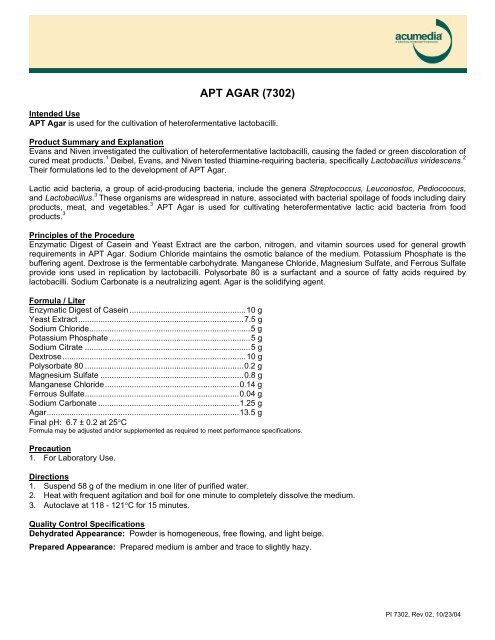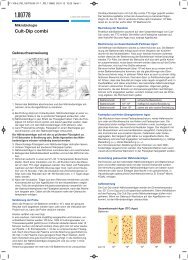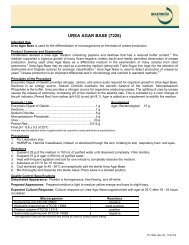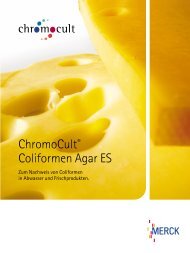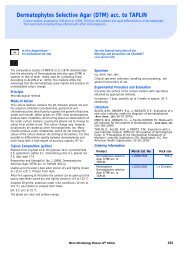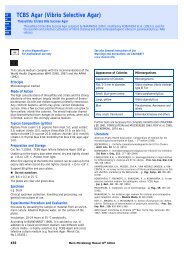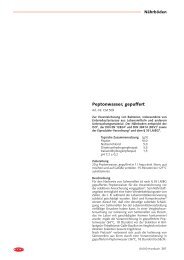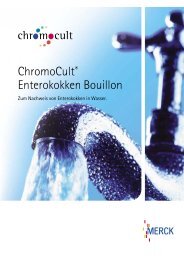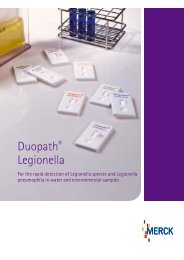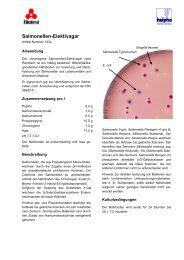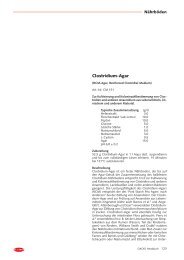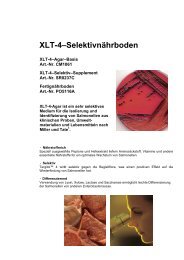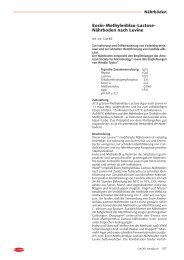APT Agar (7302) - mibius
APT Agar (7302) - mibius
APT Agar (7302) - mibius
You also want an ePaper? Increase the reach of your titles
YUMPU automatically turns print PDFs into web optimized ePapers that Google loves.
<strong>APT</strong> AGAR (<strong>7302</strong>)Intended Use<strong>APT</strong> <strong>Agar</strong> is used for the cultivation of heterofermentative lactobacilli.Product Summary and ExplanationEvans and Niven investigated the cultivation of heterofermentative lactobacilli, causing the faded or green discoloration ofcured meat products. 1 Deibel, Evans, and Niven tested thiamine-requiring bacteria, specifically Lactobacillus viridescens. 2Their formulations led to the development of <strong>APT</strong> <strong>Agar</strong>.Lactic acid bacteria, a group of acid-producing bacteria, include the genera Streptococcus, Leuconostoc, Pediococcus,and Lactobacillus. 3 These organisms are widespread in nature, associated with bacterial spoilage of foods including dairyproducts, meat, and vegetables. 3 <strong>APT</strong> <strong>Agar</strong> is used for cultivating heterofermentative lactic acid bacteria from foodproducts. 3Principles of the ProcedureEnzymatic Digest of Casein and Yeast Extract are the carbon, nitrogen, and vitamin sources used for general growthrequirements in <strong>APT</strong> <strong>Agar</strong>. Sodium Chloride maintains the osmotic balance of the medium. Potassium Phosphate is thebuffering agent. Dextrose is the fermentable carbohydrate. Manganese Chloride, Magnesium Sulfate, and Ferrous Sulfateprovide ions used in replication by lactobacilli. Polysorbate 80 is a surfactant and a source of fatty acids required bylactobacilli. Sodium Carbonate is a neutralizing agent. <strong>Agar</strong> is the solidifying agent.Formula / LiterEnzymatic Digest of Casein ....................................................10 gYeast Extract..........................................................................7.5 gSodium Chloride........................................................................5 gPotassium Phosphate ...............................................................5 gSodium Citrate ..........................................................................5 gDextrose..................................................................................10 gPolysorbate 80 .......................................................................0.2 gMagnesium Sulfate ................................................................0.8 gManganese Chloride............................................................0.14 gFerrous Sulfate.....................................................................0.04 gSodium Carbonate ...............................................................1.25 g<strong>Agar</strong>......................................................................................13.5 gFinal pH: 6.7 ± 0.2 at 25°CFormula may be adjusted and/or supplemented as required to meet performance specifications.Precaution1. For Laboratory Use.Directions1. Suspend 58 g of the medium in one liter of purified water.2. Heat with frequent agitation and boil for one minute to completely dissolve the medium.3. Autoclave at 118 - 121°C for 15 minutes.Quality Control SpecificationsDehydrated Appearance: Powder is homogeneous, free flowing, and light beige.Prepared Appearance: Prepared medium is amber and trace to slightly hazy.PI <strong>7302</strong>, Rev 02, 10/23/04
Expected Cultural Response: Cultural response on <strong>APT</strong> <strong>Agar</strong> at 35°C after 18 - 72 hours incubation.MicroorganismLactobacillus fermentum ATCC® 9338Leuconostoc mesenteroides ATCC® 12291ResponsegrowthgrowthThe organisms listed are the minimum that should be used for quality control testing.Test ProcedureRefer to appropriate references for specific procedures using <strong>APT</strong> <strong>Agar</strong>.ResultsRefer to appropriate references and procedures for results.StorageStore sealed bottle containing the dehydrated medium at 2 - 30°C. Once opened and recapped, place container in a lowhumidity environment at the same storage temperature. Protect from moisture and light by keeping container tightlyclosed.ExpirationRefer to expiration date stamped on the container. The dehydrated medium should be discarded if not free flowing, or ifappearance has changed from the original color. Expiry applies to medium in its intact container when stored as directed.Limitation of the ProcedureDue to varying nutritional requirements, some strains may be encountered that grow poorly or fail to grow on this medium.Packaging<strong>APT</strong> <strong>Agar</strong> Code No. <strong>7302</strong>A 500 g<strong>7302</strong>B 2 kg<strong>7302</strong>C 10 kgReferences1. Evans, J. B., and C. F. Niven, Jr. 1951. Nutrition of the heterofermentative lactobacilli that cause greening of cured meat products. J. Bact. 62:599-603.2. Deibel, R. H., J. B. Evans, and C. F. Niven, Jr. 1957. Microbiological assay for thiamine using Lactobacillus viridescens. J. Bact. 74:818-821.3. Vedamuthu, E. R., M. Raccach, B. A. Glatz, E. W. Seitz, and M. S. Reddy. 1992. Acid-producing microorganisms, p. 225-238. In C. Vanderzant,and D. F. Splittstoesser (eds.). Compendium of methods for the microbiological examination of foods, 3 rd ed. American Public Health Association,Washington, D.C.Technical InformationContact Acumedia Manufacturers, Inc. for Technical Service or questions involving dehydrated culture media preparation or performance at (517)372-9200 or fax us at (517)372-2006.PI <strong>7302</strong>, Rev 02, 10/23/04


